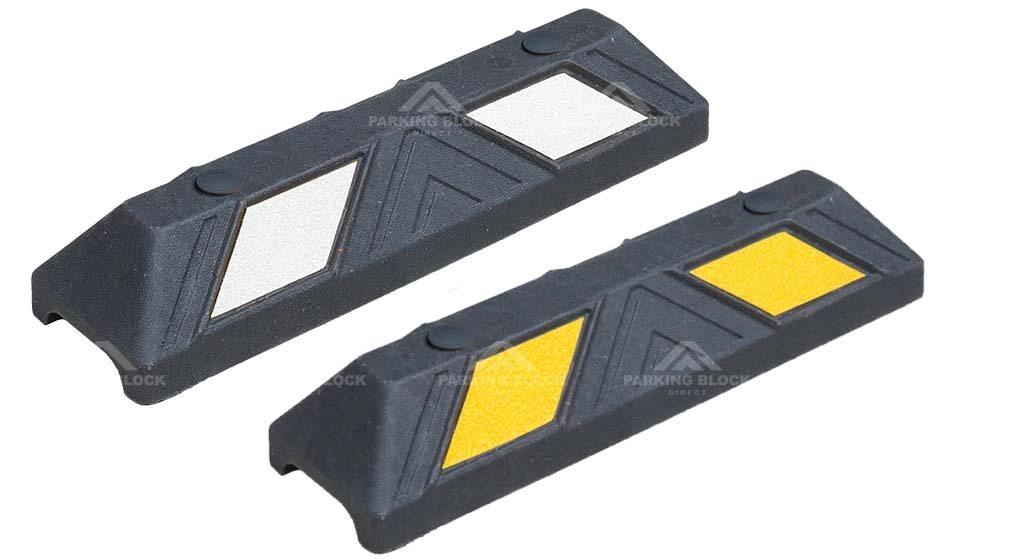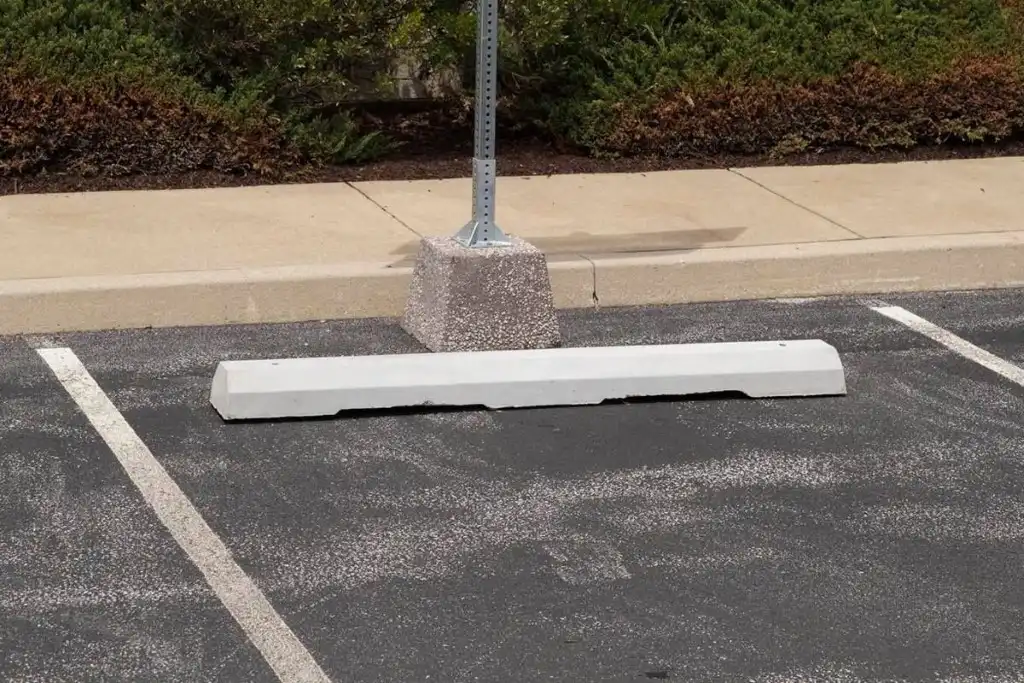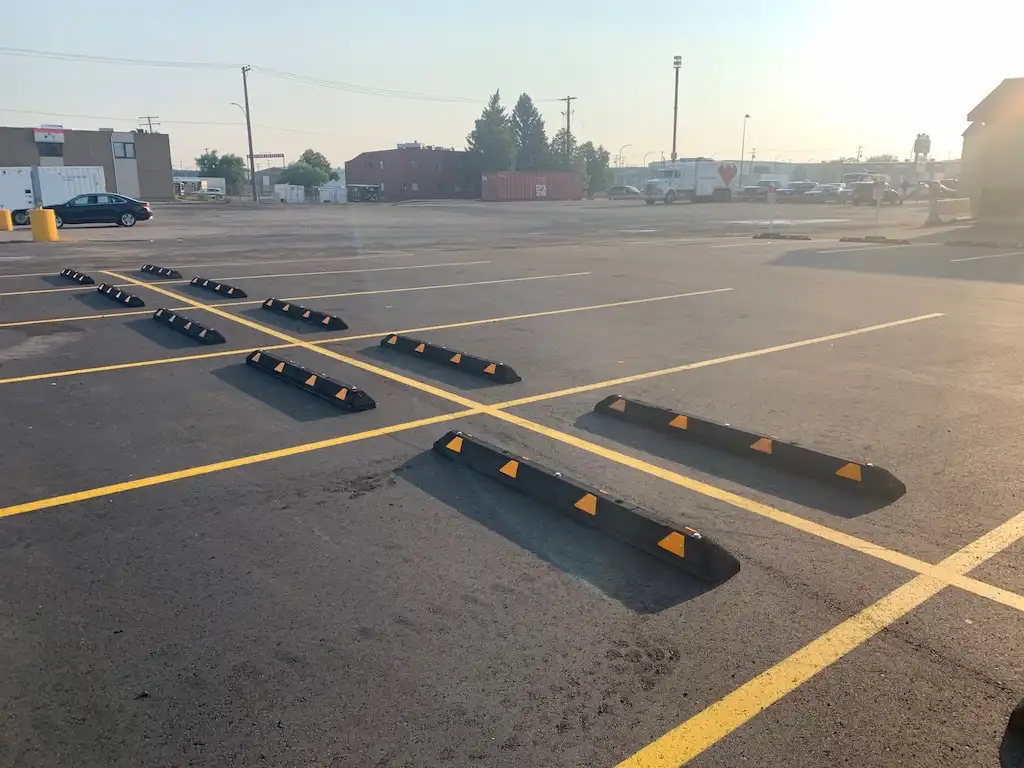Parking Stops: What Are They?
You may notice these small, sturdy blocks at the end of each parking space when you go to a parking lot.
These parking blocks, also known as parking stops, wheel stops, curb stops, or bumper blocks, serve an essential function in parking lots.
In this article, we will discuss the basics of parking stops, their history, and the different names they are known by.
For more information, feel free to discover here: All You Need to Know About Parking Blocks.
A Basic Introduction to Parking Stops
Parking stops, also known as wheel stops, are an important feature in parking facilities. They are small blocks made of concrete, rubber, or plastic that are placed at the end of each parking space to prevent cars from rolling too far forward and causing damage to other parked vehicles or property.
Parking stops are typically 2 to 6.5 feet long and 4 to 6 inches high and are painted in bright colors like yellow or white for maximum visibility. Reflective strips or markers may also be added to enhance visibility in low-light conditions.
In addition to their safety benefits, parking stops also help drivers properly park their cars within the designated parking space. This prevents them from parking too close to other cars or hitting the curb, which can cause damage to their car or the parking lot itself.
Parking stops are just one of the many parking options available to drivers. Other parking options include street parking, parking permits, metered parking, parking garages, and off-street parking. Drivers can find information about parking availability, rates, and regulations by checking signage, using parking apps like Parkmobile, or contacting parking services.

What is the History of Parking Curbs?
The history of parking curbs can be traced back to the early 1900s when automobiles began to gain popularity.
At that time, there were no designated parking spaces or markings on the ground, and drivers would park their cars wherever they could find space. This often led to chaos, with cars parked haphazardly, blocking traffic and causing accidents.
To address this problem, parking curbs were introduced in the 1920s. These curbs were typically made of concrete and placed at the roadway’s edge to mark the parking area.
As cars became larger and heavier over time, it became necessary to install stronger curbs to prevent them from rolling over the edge of the roadway. The modern parking stop was born from this need and has since become a standard feature in parking lots worldwide.
Overall, parking curbs have played a crucial role in developing modern parking spaces and have helped to make parking safer and more organized for drivers worldwide.

FEEL FREE TO CONTACT US
OUR FACTORY
Parking Block Direct is a well-known wheel stop manufacturing company located in Qingdao.
Since 2013, we have produced and distributed premium-quality products across different countries to help people improve vehicular and pedestrian safety in public parking lots and garages.
OUR WORLDWIDE DELIVERY
We ship our products in reliable packing worldwide. We ensure our products are delivered to your doorstep in the best possible condition for your public parking garage.
No matter where you live, contact us and learn about the shipping process, delivery date, or any other questions.
What are the Different Names of Wheel Stops?
Parking stops are known by various names, depending on the region and industry. Some of the common names include:
Wheel Stops
Using wheel stops is common in parking areas to prevent vehicles from rolling beyond their designated parking space. These stops are made of different materials such as concrete, rubber, or plastic and are usually around 4 inches tall and 2-6.5 feet long.
Wheel stops are particularly beneficial in busy parking lots and garages where there is a need to optimize the available parking space and ensure that vehicles are parked accurately. Parking attendants also use them to indicate where parking is not allowed, such as in no-parking zones or areas reserved for people with disabilities.
In addition to preventing vehicles from rolling beyond the parking space, wheel stops can also help improve pedestrian safety by providing a clear boundary between the parking area and the walking paths. This separation can prevent accidents and ensure pedestrians stay safe while navigating the parking lot.
Furthermore, wheel stops can help drivers to park their vehicles by providing a visual reference point to indicate the end of the parking space. This can help to avoid situations where vehicles overhang into pedestrian walkways or other parking spots.
Overall, wheel stops are a simple yet effective solution to ensure vehicles are parked safely and correctly. They help to reduce the risk of accidents and improve overall parking organization.
Parking Curb Stops
Parking curb stops, also known as parking curbs, play a vital role when parking on busy commercial or residential streets. Parking curbs are designed to prevent vehicles from rolling onto the sidewalk or other areas, making them a useful tool for ensuring pedestrian safety. Made of durable materials, such as concrete, parking curb stops are typically around 4 inches tall and 2-6.5 feet long.
When parking in a lot or garage, it is important to look for designated parking spots that have parking curb stops. These parking curbs can help guide drivers into parking spaces and ensure that vehicles are parked safely and orderly.

Car parking Bumpers
Car parking bumpers, also known as parking bumpers, are a type of parking stop designed to prevent vehicles from hitting obstacles beyond the parking space, such as walls or other cars.
They are typically made of concrete, rubber, or plastic and are around 4 inches tall and 2-6.5 feet long. Car parking bumpers are particularly useful in areas with limited space, where it is essential to ensure that vehicles are parked correctly.
In addition to preventing vehicles from hitting obstacles beyond the parking space, parking bumpers can also help improve the parking area’s overall safety. They can be placed strategically to guide vehicles safely into and out of parking spaces, reducing the risk of accidents.
Parking Curbs
Parking curbs serve several functions besides preventing cars from rolling over the curb. They also act as visual markers, guiding drivers to park their vehicles correctly and avoid encroaching on adjacent parking spaces.
This feature helps to maximize the number of available parking spaces, allowing for more efficient use of parking areas. Additionally, parking curbs can protect vehicles from potential damage caused by other parked vehicles, reducing the need for costly repairs.
Overall, parking curbs are essential in maintaining safety in hilly or steep areas, ensuring that vehicles are parked correctly, and minimizing the risk of accidents.

Conclusion
Parking stops, also known as wheel stops, curb stops, or bumper blocks, are essential features of parking lots. They guide drivers, prevent damage to cars and property, and improve safety in parking lots.
Understanding the basics of parking stops, their history, and the different names they are known by can help you make informed decisions about parking lot design and management. Whether you are a parking lot owner, driver, or pedestrian, parking stops are important in keeping everyone safe and organized.
For further information, feel free to check the following pages:
hello@parkingblockdirect.com
